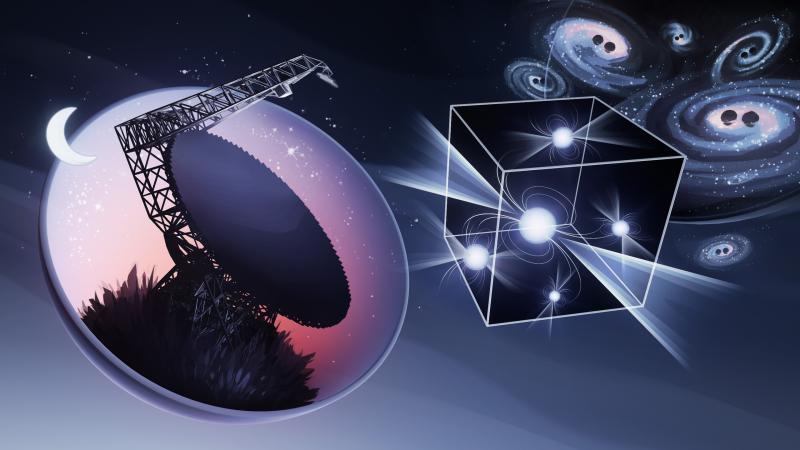
We monitor an array of radio pulsars with the Green Bank Telescope in order to detect gravitational waves from the supermassive black holes at the cores of distant galaxy mergers. Illustration: Olena Shmahalo

We monitor an array of radio pulsars with the Green Bank Telescope in order to detect gravitational waves from the supermassive black holes at the cores of distant galaxy mergers. Illustration: Olena Shmahalo
We observe with the largest telescopes in the world in order to detect electromagnetic waves with the very longest wavelengths. Radio astronomy allows us to probe energetic processes which are invisible to optical telescopes.
Since the birth of radio astronomy in the 1930s, astronomers have been observing the universe not only with the visible light we see with our eyes, but also with the natural radio waves that come from the sky. Here on Earth, we associate radio waves with communication, but in fact Nature (including your own body at this moment!) is constantly making radio noise. Since most radio waves pass through the Earth’s atmosphere, it’s always nighttime in the radio sky. Radio astronomers observe phenomena from stars, planets, galaxies, and the early universe. NANOGrav astronomers in particular study the radio emission from pulsars. Our collaboration uses the world's most sensitive radio telescopes to discover and observe millisecond pulsars, the fastest spinning objects in the universe. Our facilities include the Green Bank Telescope in West Virginia, the Very Large Array in New Mexico, and the Canadian HI Intensity Mapping Experiment (CHIME) telescope in British Columbia. Our datasets also contain historical data from the former 305-m William E. Gordon Telescope located at the Arecibo Observatory in Puerto Rico.
A quick overview of Radio Astronomy by the our collaborative partners at the Commonwealth Scientific and Industrial Research Organisation (CSIRO).
The radio telescopes NANOGrav uses are general-purpose and are used all the time for other projects. Some of these other projects study pulsars in and of themselves. Others focus on other radio astronomy research topics: mapping the hydrogen emission from our Milky Way galaxy and others, studying the molecular composition of interstellar clouds, and radio bursts from other galaxies, known as fast radio bursts—just to name a few. In addition to astronomy, these giant radio telescopes are also involved in radar astronomy, (bouncing radio signals off of solar system objects), and yes, in searching for radio signals from extraterrestrial intelligence.
NANOGrav science, in the long term, benefits the ongoing usage and development of our telescopes. In the case of the Green Bank Telescope, the National Science Foundation-funded NANOGrav Physics Frontiers Center and the Gordon and Betty Moore Foundation have together funded the facility for observing time and for instrument development. While the Moore Foundation has funded the new Ultra Wide Band receiver with NANOGrav science in mind, this powerful, advanced instrument will be applicable to a wide range of radio astronomy applications.